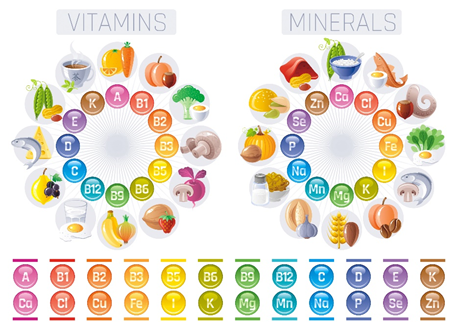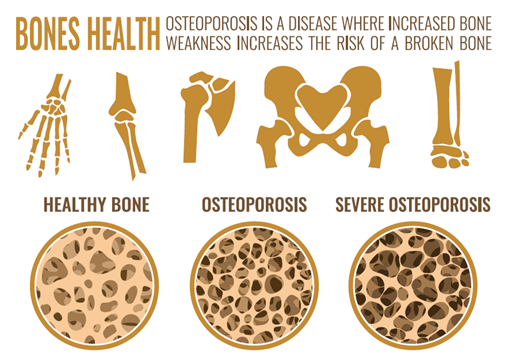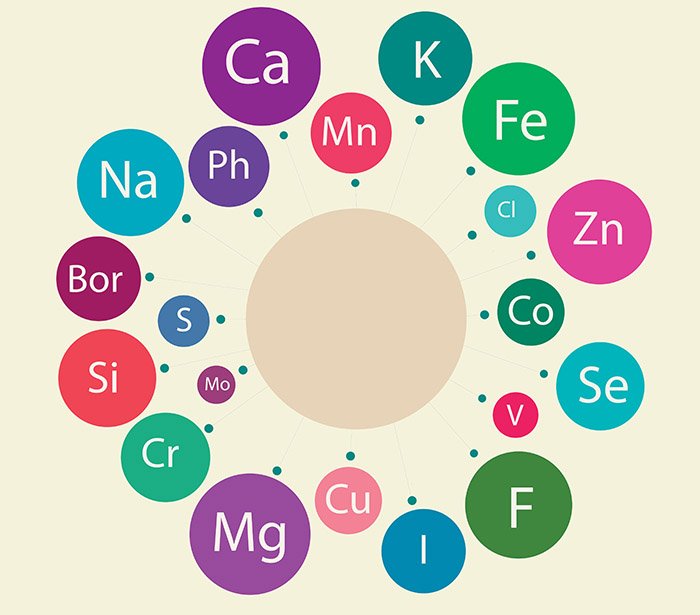By KAT BAREFIELD MS, RDN, NASM-CPT, CES, PES, ACSM-HFS
In this post, we’re going to explore the health effects of getting insufficient micronutrients (vitamins and minerals).
This article will also cover:
- The critical functions of various micronutrients
- The most common under-consumed micronutrients in the U.S.
- Recommended daily amounts for each under-consumed vitamin and mineral
- Food sources that are rich in vitamins and minerals
- Evidence related to multivitamins and other supplements
If any of these topics interest you, keep reading. And be sure to check out our Making Sense of Supplements Course – which is a part of our Certified Nutrition Coach course.
Micronutrients are also an essential part of Sports Nutrition – be sure to check out the NASM Sports Nutrition Coach course for how crucial nutrition is for coaching athletes.
OVERVIEW OF METABOLISM
“Metabolism” is a commonly used term by trainers and fitness enthusiasts alike. Have you ever stopped to think what it is? This may help:

(Image Credit: Shutterstock.com)
The drawing depicts the countless reactions that occur continuously to keep you alive with little to no effort on your behalf. Breathing, thinking, your heart beating, digestion, circulation, movement, and so on. Amazing right?
So, what does it take to keep all these reactions going? Nutrients (and oxygen).
THE SIX CLASSES OF ESSENTIAL NUTRIENTS
There are six classes of essential nutrients for human health, meaning we can’t live without them without negative consequences. Our bodies don’t make them so, we must obtain them from our diet. They include:
- Carbohydrates
- Protein
- Fats
- Vitamins
- Minerals
- Water
Carbohydrates, protein, and fats are collectively named macronutrients because we need them in large quantities.
They provide calories or energy in the form of ATP to run all metabolic reactions, which are jumpstarted by proteins called enzymes. Enzymes need cofactors to work, and that is where vitamins and minerals (micronutrients) come in. We need these in smaller quantities.
CRITICAL FUNCTIONS OF SELECTED MICRONUTRIENTS:
- B vitamins are needed to extract energy from food
- Vitamin B12 is required for proper nerve function and to make red blood cells
- Vitamin A is needed for good vision, immunity, and healthy skin
- Vitamin D is required to form bone, healthy immune function, and functions as a hormone throughout the body
- Vitamin E is an antioxidant and helps protect cells from damage
- Vitamin K is needed to form blood clots and to shuttle calcium into bone
- Calcium is needed for muscle contraction and bone formation
- Iron is required to transport oxygen throughout the body
- Magnesium regulates muscle contraction and nerve transmission. It helps form teeth and bones and is needed in over 300 metabolic reactions.
- Potassium is needed for muscle contraction, proper nerve conduction, and maintenance of fluid and electrolyte balance
There are approximately 30 vitamins and minerals we need to consume regularly. Many have multiple functions and work synergistically to run your metabolism to keep you alive and healthy.
Some even help with offsetting the symptoms of COVID.
The image below shows the various food sources of micronutrients.

(Image Credit: Shutterstock.com)
HOW MUCH DO YOU NEED?
Scientists at the Institute of Medicine have established amounts of micronutrients to consume daily, referred to as RDAs (Recommended Dietary Allowances) based on age, gender, and life stage. It is important to note that these recommended values aim to prevent deficiencies and their related diseases and conditions and are not necessarily optimal for longevity.
As a registered dietitian, my advice is to eat a wide variety of colourful and minimally processed foods from all major food groups. This will maximize your nutrient intake while staying within your calorie needs to either maintain healthy body weight or achieve one.
HERE’S WHAT A MICRONUTRIENT-RICH DIET LOOKS LIKE FOR SOMEONE WHO NEEDS 2,200 CALORIES PER DAY:
- 3 cups of vegetables a day, distributed as follows:
- 2 cups per week of dark-green vegetables (Think spinach! Which is also high in iron.)
- 6 cups per week of red and orange vegetables
- 2 cups per week of legumes (beans and peas)
- 6 cups per week of starchy veggies (potatoes, green peas, corn, plantains)
- 5 cups per week of other veggies (iceberg lettuce, mushrooms, onions, cabbage)
- 2 cups a day of fruit
- 3 ½ ounces of whole grains (whole wheat bread, brown rice, oatmeal, quinoa)
- 3 ½ ounces of other refined enriched grains (white rice, refined grain cereals, pasta)
- 3 cups of dairy
- 6 ounces of protein broken down as follows:
- 9 ounces per week of seafood
- 28 ounces per week of meats, poultry, eggs
- 5 ounces per week of nuts, seeds, soy
- 29 grams of oils
How do you suppose Americans measure up to the recommendations above for getting sufficient vitamins and minerals?
In the United States and other developed countries, overt deficiencies and their related diseases are rare. However, insufficiencies or intakes below the RDAs are common. The 2015-2020 Dietary Guidelines for Americans report identified nine widely under-consumed nutrients. These include:
- Calcium
- Magnesium
- Potassium
- Vitamin D
- Vitamin A
- Vitamin C
- Vitamin E
- Choline
- Fibre
Put another way, the top six sources of calories in the U.S diet identified by the Dietary Guidelines Committee include:
- Desserts (grain-based, i.e., cakes, cookies, doughnuts, etc.)
- Bread
- Chicken and chicken mixed dishes
- Soda
- Pizza
- Alcoholic beverages
It’s safe to say that most Americans are not eating a micronutrient-rich diet. And with pizza being the #5 source of calories, you can bet diets are high in sodium.
SO, WHAT HAPPENS WHEN YOU DON’T GET ENOUGH MICRONUTRIENTS?
Since vitamins and minerals are required for numerous physiological processes in the body, chronic shortages will negatively impact various health and metabolism aspects.
There is evidence that micronutrient insufficiencies are linked to multiple age-related chronic diseases, including cancer, osteoporosis, and heart disease. (McCann, Ames, 2011) (Ames, 2018)
FOLATE AND THE BIRTH OF THE PRENATAL VITAMIN
Folate (vitamin B9) is naturally present in legumes and leafy greens. It is required for the synthesis of DNA and supports cell growth and repair. Insufficient folate in the body is linked to neural tube defects, and there’s evidence for its role in preventing strokes. (McNulty, Pentieva, Hoey, Strain, Ward, 2012)
The bioavailability of folate in food is limited, meaning the body cannot extract it and use it. In contrast, the synthetic form, folic acid, has much greater stability and bioavailability and is more effective at raising its stores.
Multivitamin and mineral formulas with folic acid have proven to decrease neural tube defects. The prenatal vitamin is currently a worldwide recommendation during pregnancy and for women of childbearing age. (Czeizel, Dudás, 1992)
In 1998, folic acid was added to the U.S. food supply through fortification of refined grain products, and the prevalence of newborns with neural tube defects has dropped. Whether you realize it or not, you’ve been supplementing your diet for quite some time.
CALCIUM AND BONE-BUILDING MICRONUTRIENTS
Most Americans do not reach the daily requirements of bone-building nutrients, calcium, magnesium, vitamin K, and vitamin D due to poor food choices, food preferences, access, and other factors. In calcium, 99% is stored in the skeletal structure, and 1% is tightly maintained in the blood at 8.4 to 9.5 mg/dL to keep essential functions running.
When you don’t consume adequate amounts of calcium, the body will break down bone to maintain blood levels to keep your heart beating. Over time, chronic shortages of calcium and synergistic nutrients lead to weakened bones and osteoporosis.
You survive in the short term at the expense of long-term health.

(Image Credit: Shutterstock.com)
Insufficient amounts of micronutrients lead to undetectable damage, which can speed up the age-related disease. And because people don’t see or feel the damage occurring, they don’t realize there’s a problem until it’s too late.
For example, in Vitamin K, the clotting proteins get it first… and only after they’re satisfied with preventing calcification of the arteries, preventing cancer, or preventing bone fractures. It’s all insidious damage that you get. That’s a long-term consequence. We call these the diseases of ageing. – Bruce Ames
HOW MULTIVITAMINS AND OTHER SUPPLEMENTS CAN HELP
Take a moment to answer the following questions:
- Do you have medical insurance?
- Do you have dental insurance?
- Do you have car insurance?
- Do you have renters or mortgage insurance?
- What about life insurance?
- And pet insurance?
- Why do you have all these types of insurance?
- Now, do you have nutritional insurance?
Nutritional insurance, in the form of a low dose multivitamin and mineral containing a broad range of under-consumed micronutrients and, is suitable for your age, gender, life stage, and activity level covers your vitamin and mineral needs “just in case” you aren’t getting them all from food daily. (Blumberg, Cena, Barr, 2018)
As discussed, most don’t get everything they need from food alone.
A properly made multivitamin certainly doesn’t replace a well-rounded diet, but rather complements your food intake to ensure you’re getting the micronutrients you need.
SUPPLEMENTS TO CONSIDER IF YOUR DIET IS LACKING
Supplements to consider if you’re not getting enough from your diet include calcium, iron, vitamin D, or omega-3 fish oils. Doing so would help reach recommended levels and would also serve as nutritional insurance.
Survey data consistently shows that people who use supplements have fewer micronutrient insufficiencies and/or higher micronutrient intakes. For instance, compared to food alone, taking a multivitamin and mineral was associated with a lower prevalence of inadequacies for 15 of 17 micronutrients examined. (Ames, 2018)
Another study showed that multivitamin and mineral supplements significantly reduced the prevalence of insufficient intakes of calcium, magnesium, vitamins A, C, D and E. (McCann, Ames 2009)
Similar findings in other countries have been published.
SUMMARY
The human body is programmed for survival and has sophisticated mechanisms for addressing chronic shortages of micronutrients by rationing their use for proteins and functions essential to keeping you alive while sacrificing vitamin and mineral dependent proteins critical for long-term health.
Therefore, meeting daily recommended amounts of the ~30 micronutrients is equally essential as hitting your daily macros.
To maximize your micronutrient intake, you will need to consistently eat various food sources from all the major food groups. Dieting for weight loss, avoiding entire food groups, or eating the same foods with little variety limits your micronutrient intake and leads to more significant vitamin and mineral insufficiencies.
Despite a plethora of healthy eating guidelines, the data clearly and repeatedly shows that most Americans fall short of several vital micronutrients, setting themselves up for chronic disease and other health issues. Remember that overweight and obese individuals, who make up approximately 70% of the U.S adult population, consume obesogenic diets high in calories and low in micronutrients. The obese have the highest rates of chronic disease.
Using a low dose of multivitamins and minerals has proven to help raise intakes to the recommended amounts needed to support physiological functions to meet the body’s immediate demands while supporting long-term health.
Nothing replaces a good diet and other healthy behaviours such as adequate sleep, regular exercise, managing stress, and maintaining a healthy body weight. In the case of micronutrients, a little insurance goes a long way.
If you are interested, consider becoming a nutrition specialist with NASM today!

